 |
 |
 |
 |
| |
||||
Laser Hair RemovalA CBS 2 News Special Assignment 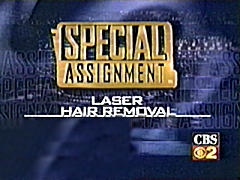 It's not what you see, but what you don't see that's considered attractive. It's not what you see, but what you don't see that's considered attractive. You don't see women with moustaches and hairy armpits or men with hair all over their backs. That perception of what's attractive is sending droves of men and women to their doctors' offices to undergo laser hair-removal surgery. But does it really work? And is it really safe? CBS 2 News' Lonni Leavitt investigates. Special Assignment: Laser Hair Removal aired Wednesday, June 11, 1998 at 11 p.m. "We just did about 120 hairs instantaneously in a second," Dr. Edward Tobinick, a dermatologist, told CBS 2 News after a procedure. About 70 percent of Dr. Tobinick's patients are women, though he does see a number of men, said Leavitt. Men like Check Glabberman -- who's come to have hair removed from his ears. "I suddenly realized that the older one gets, there's hair just popping up all over," Glabberman told CBS 2 News. "And I just can't stand it." "There's no pre- or post-operative medication. There's no healing time. It's all done just in a matter of a few minutes," Tobinick said. "I recommend it highly," one of his patients told CBS 2 News. Over at Dr. Ronald Moy's office, a different laser is used to get the same result. Moy uses the Long-Pulse Ruby Laser, said Leavitt. Then there's the newest laser on the market. It's called the Alexandred Laser, said Leavitt. Using the laser, it took Dr. Kathleen Adair only about a minute to perform the procedure on a patient's upper lip. "I don't want to look like my grandfather," the female patient said. The laser works by going right through your skin, zapping the hair follicle without harming your external skin. But according to Leavitt, that brings out the limitations of the procedure. To really zap the hair, the hair must be darker than the skin color, said Leavitt. And there are other shortcomings. Although many ads say it's permanent hair removal, that's not completely true. "The way I word it to a patient, it's long-term removal," Dr. Moy said. "At least when the hair comes back, it's thinner and it doesn't come back as frequently." "When you use any treatment to remove hair, you know that you're only going to get part of the hair to stay away because the hair grows in cycles," Dr. Adair told Leavitt. The lasers all seem to be very comparable, said Leavitt. But they're so new, there's not much research available on them. Only doctors, or those under a doctor's supervision, can use the laser in California. As for the risk, they can be dangerous. In some cases, patients will see some soreness, puffiness and possible skin burns from the lasers, said Leavitt.
|
|
 |
|
|
Retire Rich
 |

 |
||
|
12 p.m.
Woman 2 Woman One of the stars from "Judging Amy" 5 p.m. 6 p.m. 11 p.m.
|
||
 |
||
|
4-5 p.m.
Judge Judy Ruler Of The Free World! 8:00 p.m. 8:30 p.m.
9:00 p.m.
|
||
| |
||
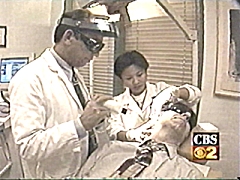 Laser hair removal is easy, fast and -- for most people -- relatively pain-free, reported CBS 2 News' Lonni Leavitt.
Laser hair removal is easy, fast and -- for most people -- relatively pain-free, reported CBS 2 News' Lonni Leavitt. 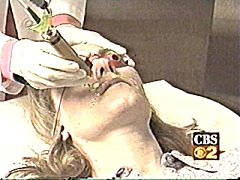 There are a number of lasers out there. CBS 2 News' I-Team looked at three of them, starting with Dr. Tobinick's laser: the Photolisus HR.
There are a number of lasers out there. CBS 2 News' I-Team looked at three of them, starting with Dr. Tobinick's laser: the Photolisus HR. 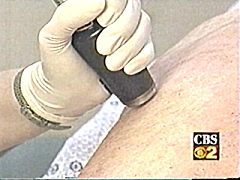 "The main benefit is if you compare electrolysis, you have to stick a needle down each hair follicle," Dr. Moy said. "With lasers, you can actually treat a whole lip area in just a few minutes."
"The main benefit is if you compare electrolysis, you have to stick a needle down each hair follicle," Dr. Moy said. "With lasers, you can actually treat a whole lip area in just a few minutes." 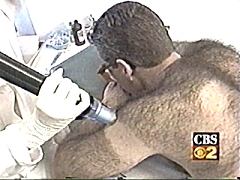 "Not everyone is a candidate. Patients with dark skin can only be done to a limited degree," Dr. Tobinick told CBS 2 News.
"Not everyone is a candidate. Patients with dark skin can only be done to a limited degree," Dr. Tobinick told CBS 2 News. 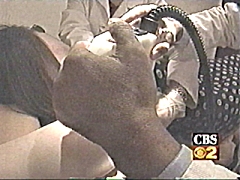 That means it's most likely not a one-time treatment, reported Leavitt. The procedure costs, on average, about $500 for a small area. Often times, patients will need three to five treatments, along with touch-ups down the road.
That means it's most likely not a one-time treatment, reported Leavitt. The procedure costs, on average, about $500 for a small area. Often times, patients will need three to five treatments, along with touch-ups down the road. 

